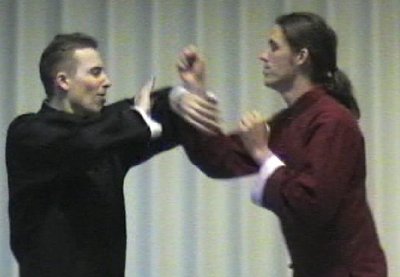The Bong Sao
by Rien Bul
The Bong Sao is probably the most elusive movement in Weng Shun Kuen. Unfortunately, it has been as elusively to many Weng Shun Kuen stylists as to their opponents.
To a person trained in Weng Shun Kuen a fight begins at the first moment of contact. We first make contact with an opponent through usage of the Man Sao movement to slap an attack off its intended direction. While keeping contact, we next position ourselves behind our technique and face the point of contact (see Footwork and Positioning).
But sometimes an opponent is strong and fast enough to hit through the Man Sao and make it collapse before we can change position to strengthen it with our footwork. In such a case the Weng Shun Kuen practitioner moves his elbow upward, thus creating the movement known as Bong Sao or Wing Arm.
Fear makes most people use the Bong Sao as a blocking technique. The Bong Sao is not a block. It is not static. It is a transitional movement in between two movements. The Bong Sao slows down the opponent, buying you time to go to his outside.
Have the courage to be "soft". Don’t use any muscular strength in your Bong Sao. Don’t push your opponent away from you. Close combat is the most advantageous distance for Weng Shun Kuen. Just move outside of his arm. Be Yin (yielding). Let the opponent be Yang (forceful). The "Law of balance" in Weng Shun Kuen states: "The more an opponent excerts force, the more a Weng Shun Kuen practitioner yields". While going to the outside, change your Bong Sao to a balance-disrupting movement like, for instance, a Lop Sao movement.
A transition seqeunce, like for example Man Sao-Tan Sao-Noi Fook Sao-Lop Sao, should be one movement. It should flow from one technique into the next so fast, an observer would not be able to tell them apart from each other. This can only be attained through relaxation. So always stay calm and have faith in what you have learned.

Click picture to view Bong Sao Video